May 20, 1930 – Geophysicists establish Professional Society –
Earth scientists in Houston established the Society of Economic Geophysicists to encourage the ethical practice of geophysics in the exploration and development of natural resources. The organization in 1937 adopted the name Society of Exploration Geophysicists (SEG), which in 2024 reported 14,000 members in 114 countries.
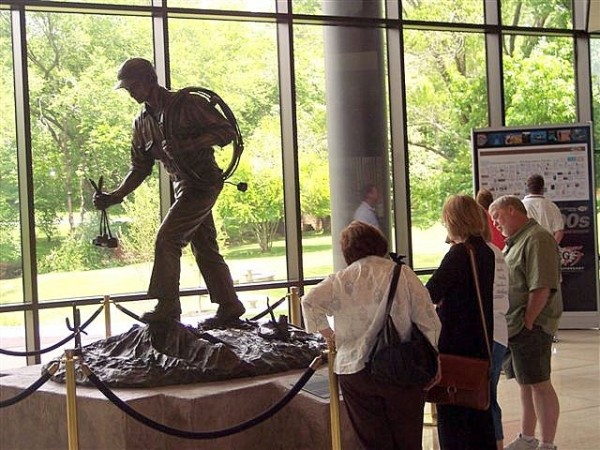
The Doodlebugger by Oklahoma sculptor Jay O’Melia has welcomed visitors to SEG headquarters since 2002. Photo by Bruce Wells.
SEG’s journal Geophysics began publishing in 1936 with articles on exploration technologies, including seismic, gravity, and magnetic imaging. The journal warned of hucksters using vague or unproven properties of oil and geological formations. At its Tulsa headquarters in 2002, SEG unveiled The Doodlebugger, a 10-foot bronze statue by Oklahoma sculptor Jay O’Melia, who also sculpted the Oil Patch Warrior, a World War II memorial.
May 21, 1923 – “Esso” first used by Standard Oil Company
For the first time, Standard Oil Company of New Jersey used “Esso” to market the company’s “refined, semi-refined, and unrefined oils made from petroleum, both with and without admixture of animal, vegetable, or mineral oils, for illuminating, burning, power, fuel, and lubricating purposes, and greases.”

Standard Oil of New Jersey’s logo from 1923 to 1934, when the text became much plainer and inside an ellipse.
In 1923, Esso — the phonetic spelling of the abbreviation “S.O.” for Standard Oil — became a registered trademark. The future children’s book author, Theodore Geisell, began drawing Essolube product ads in the 1930s. Exxon (now ExxonMobil) removed its U.S. Esso brand in 1973.
May 23, 1905 – Patent issued for Improved Metal Barrel Lid
Henry Wehrhahn, superintendent for the Iron Clad Manufacturing Company of Brooklyn, New York, received the first of two 1905 patents that presaged the modern 55-gallon oil drum. The first design included “a means for readily detaching and securing the head of a metal barrel.”
Wehrhahn assigned his patent rights to the widow of Robert Seaman, founder of Iron Clad Manufacturing — Elizabeth Cochrane Seaman, journalist Nellie Bly. In December 1905, Wehrhahn also assigned her the rights to his improved metal barrel patent.
Learn more in Remarkable Nellie Bly’s Oil Drum.
May 23, 1937 – Death of World’s Richest Man
Almost 70 years after founding Standard Oil Company in Ohio and 40 years after retiring from the company in 1897, John D. Rockefeller died in Ormond Beach, Florida, at age 97. His petroleum empire had peaked in 1912.
Born on July 8, 1839, in Richford, New York, Rockefeller attended high school in Cleveland, Ohio, from 1853 to 1855. He became an assistant bookkeeper with a produce shipping company before forming his own company in 1859 — the same year of the first U.S. oil well in Pennsylvania. Rockefeller was 24 in 1865 when he took control of his first refinery, which would be the largest in the world three years later.
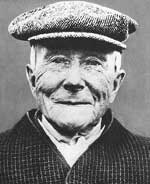
John Rockefeller, 1839-1937. Photo courtesy of Cleveland State University.
By the time his petroleum fortune peaked at $900 million in 1912 ($28.14 billion in 2023 dollars), Rockefeller’s philanthropy was well known. His unprecedented wealth funded the University of Chicago, the Rockefeller Institute for Medical Research, (now the Rockefeller Foundation), and Spelman College in Atlanta.
May 24, 1902 – Oil & Gas Journal published
Holland Reavis founded the Oil Investors’ Journal In Beaumont, Texas, to report on financial issues facing operators and investors in the giant oilfield discovered nearby one year earlier at Spindletop Hill. Reavis sold his semimonthly publication to Patrick Boyle of Oil City, Pennsylvania, in 1910.

Norman Rockwell illustrated a 1962 ad promoting the Oil and Gas Journal.
Boyle, a former oilfield scout and publisher of the Oil City Derrick, increased publication frequency to weekly and renamed it the Oil & Gas Journal. Following his death in 1920, son-in-law Frank Lauinger moved operations to Tulsa and further expanded the company, which became PennWell Publishing in 1980. The Derrick newspaper in Oil City, which began in 1885, continues to be published by the Boyle family.
May 24, 1920 – Huntington Beach Oilfield discovered in California
A Standard Oil Company well discovered the Huntington Beach oilfield. The beach town’s population grew from 1,500 to 5,000 within a month of the well drilled near Clay Avenue and Golden West Street. By November 1921 the field had 59 producing wells with daily production of 16,500 barrels of oil. Development activities and speculators drew national attention to this expansion of the Los Angeles oilfield.

Pictured here in 1926, the Huntington Beach field will produce more than one billion barrels of oil by 2000. Discovery Well Park today includes six acres with playgrounds. Photo courtesy Orange County Archives.
Huntington Beach produced more than 16 million barrels of oil in 1964, according to a 1991 Orange County Register article, which added that as oil production peaked, “the pressure of explosive population growth began pushing the wells off land that had become more valuable as sites for housing.”
May 26, 1891 – Patent will lead to Crayola Crayons
Crayola crayons began when Edwin Binney and C. Harold Smith received a patent for their “Apparatus for the Manufacture of Carbon Black.” Their refining process produced a fine, intensely black soot-like substance — a pigment far better than any other at the time.
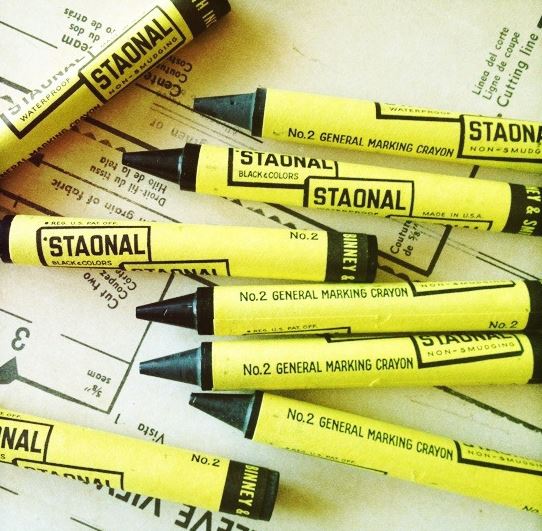
Petroleum products like carbon-black and paraffin in 1903 led to Crayola crayons and its classic marking product, Staonal. Photo courtesy Crayola.
The company mixed carbon black with oilfield paraffin to introduce a black crayon marker promoted as able to “stay on all” and accordingly named Staonal. In 1903, Binney & Smith Company began producing Crayola crayons in small batches of hand-mixed pigments and paraffin. The box included eight colors: red, orange, yellow, green, blue, violet, brown and black.
Learn more in Carbon Black and Oilfield Crayons.
May 26, 1934 – Diesel-Electric Power sets Speed Record
A new diesel-electric “streamliner,” the Burlington Zephyr, pulled into Chicago’s Century of Progress exhibition after a nonstop 13 hour “dawn to dusk” run from Denver. The trip cut traditional steam locomotive times by half.
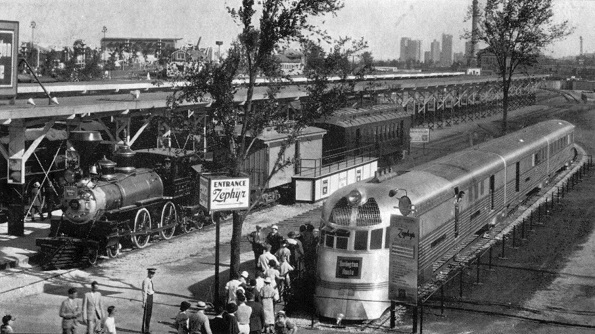
Chicago World’s Fair visitors admire the stainless steel Burlington Zephyr, which helped save America’s railroad passenger industry. Two-stroke diesel-electric engines provided a four-fold power to weight gain. Photo from a Burlington Route Railroad 1934 postcard.
Powered by a single, eight-cylinder diesel engine, the passenger train traveled 1,015 miles on its record-breaking run. The Zephyr burned just $16.72 worth of diesel fuel. The same distance for a coal-burning train would have cost $255. It had been just 60 years since steam locomotives and the transcontinental railroad linked America’s coasts.
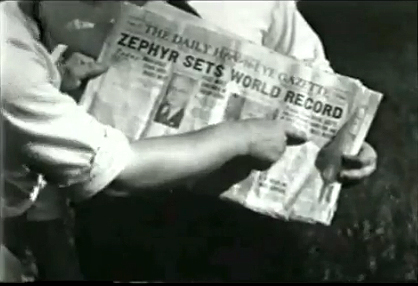
Zephyr’s engine used only $16.72 in diesel fuel.
The new diesel-electric engine technology had resulted from the U.S. Navy seeking a lighter weight, more powerful engine for its submarine fleet.
Learn more in Adding Wings to the Iron Horse.
_______________________
Recommended Reading: Careers in Geophysics (2017); A Geophysicist’s Memoir: Searching for Oil on Six Continents
(2017); Nellie Bly: Daredevil, Reporter, Feminist
(1994); Titan: The Life of John D. Rockefeller, Sr.
(2004); Huntington Beach, California, Postcard History Series
(2009); Crayola Creators: Edward Binney and C. Harold Smith, Toy Trailblazers
(2016); Burlington’s Zephyrs, Great Passenger Trains
(2004). Your Amazon purchase benefits the American Oil & Gas Historical Society. As an Amazon Associate, AOGHS earns a commission from qualifying purchases.
_______________________
The American Oil & Gas Historical Society (AOGHS) preserves U.S. petroleum history. Please become an annual AOGHS supporter and help maintain this energy education website and expand historical research. For more information, contact bawells@aoghs.org. Copyright © 2024 Bruce A. Wells. All rights reserved.



